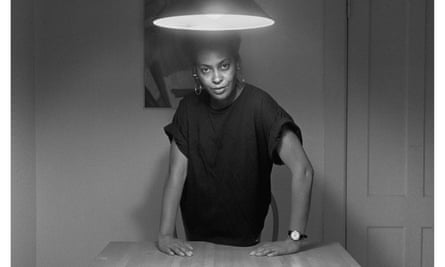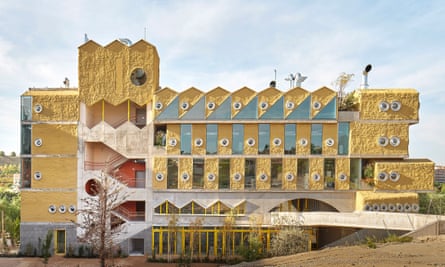Adrian Searle’s best art shows of 2023
5. Vermeer
Rijksmuseum, Amsterdam
Johannes Vermeer attracted over half a million visitors to the Rijkmuseum between February and June this year. Not bad for an artist who only produced about 37 known paintings over a 20-year period between 1654 and 1674. An exhibition of quiet intimacies and domestic mysteries, beautifully installed and spread over 10 rooms, 28 of these mostly small, interior scenes and occasional street views were presented in this stupefying exhibition, the largest ever of the artist’s work.
Serpentine Galleries, London
A helicopter takes us from the edge of London towards the husk of Grenfell Tower, in a slow and stately approach. Finally we hover and circle, turn and circle again, going in close and pulling back from the charred exterior and views into burnt-out flats where 72 people died. Filmed in 2017, before the tower was hidden behind cladding, this makes us look and remember. A unflinching, unforgettable film.
Tate Modern, London, to 25 February
Guston’s major travelling retrospective, postponed following the murder of George Floyd in Minneapolis in 2020, finally landed at Tate Modern this autumn. This riotous exhibition of socially committed early work, of beautiful, toiled-over abstractions, and the deceptively cartoonish later work, often peopled by dumb, violent Ku Klux Klansmen and melancholy images of the painter himself, is unmissable. Catch it while you can.
Barbican Gallery, London
Alice Neel was a painter of fearless and tender portraits. Her paintings unpick the dynamics not just between her sitters, but also their complicity with the artist. Neel depicted New York’s bohemia, art critics and lovers over her long career. She painted demonstrations and street life, police violence and a young man stricken with tuberculosis. Neel’s portraits are deliciously wonky appraisals of vanities and vulnerabilities, her own included.

Whitechapel Gallery, London, to 14 January
This wonderfully queer sprawl of drawings, painting and sculpture spills over with jokes, social observation and sexual candour. Working in a medley of styles and manners, the artist keeps finding new ways to describe the world. New York lesbian life in the 1990s and sessions with a shrink, the ludicrous mess of the creative life and shifts in the broader political landscape – they’re all here.
Katy Hessel’s best art shows of 2023
Laura Poitras’s poignant documentary followed artist Nan Goldin and her fight to take down the Sackler name from museums. Running parallel to the story of the disgraced Sacklers is the story of Goldin’s life. My favourite quote from the film was: “Nan photographs from the other side” – a movingly accurate description of her work for how it embodies her ability to connect with her subjects with such depth and empathy.
White Cube, Paris
Kimeze’s debut solo show demonstrated her incredible ability to carve, through dazzling hues of oil pastel, tender scenes that stand on the threshold between two places – whether it be inside/outside, in water/on land, or reality/imagination. Fluidly rendered, often with a female figure amid a wilderness of palms, Kimeze’s paintings are quietly powerful and are interspersed with speckles of glowing light.
Ben Hunter Gallery, London
A former art historian turned set designer, West Country-based artist Keith-Roach is hailed for her embellished Greek-like pots that feel both ancient and surreal. This exhibition, twinned with her husband who worked in trompe l’oeil but in painting, centred on a relic-like basin adorned with casts of materials (old phones, paper bags, sponges, rolling pine, hot water bottles – acting as a cornice) industrial items (chains, a saw) and debris. A favourite aspect was a cast Jean Paul Gautier perfume bottle that referenced the Venus de Milo – a pertinent play on the commercialised and idealised female body. Going to a Keith-Roach show always offers up surprises, and leaves you entranced with the many layers held in one artwork.

Pallant House Gallery, Chichester
I loved looking at Gwen John’s intimate portraits of girls on the cusp of adolescence. Working at the dawn of the 20th century in Paris, John painted the newfound freedoms offered to women: she captured them in rooms of their own – paid for by themselves, and no longer under the guard of men – giving us an insight into their private worlds. This show reasserted the Welsh-born artist as a key player of modernity, and showed that painting doesn’t need to shout to make an impact.
Barbican, London
This spellbinding exhibition brought together work by the US-born artist in such visionary ways. With elegance and beauty, through her art Weems connected the baroque with the present day – visually and culturally – and played with theatre and dance in her electrifying, immersive multi-screen films. Addressing urgent issues, on view were her photographs of erased signage in the wake of the 2020 Black Lives Matter protests, and photographs of herself standing stoically in front of glorified Roman monuments explored “the construction of power in western civilisation is materialised through architecture”.

Jonathan Jones’s best art shows of 2023
National Gallery, London
Catholic relics of the medieval saint’s hempen robes, images of 21st-century poverty by Andrea Büttner and a stonking homoerotic canvas by Caravaggio helped make this exhibition moving. Even for a non-believer it opened up new ways of seeing religious art and showed how ideas can change the world.
after newsletter promotion

Dulwich Picture Gallery, London, to 28 January
The baroque energy of Rubens is hard to pin down in an exhibition but this one succeeds by opting for a precise, fascinating essay on the ways he depicted women from charismatic portraits to religious theatre to nude flesh abounding on canvas. Rubens emerges as an artist to inspire and liberate.
3. Tracey Emin
Counter Editions, London Print Fair
Gory, sexy red ink saturates Emin’s astonishing new series of six gigantic nude prints, And Everything was Full of Love. The female body in these grand works is electrified by passion. They make you feel her drive to exist. Bacon, Freud – move over lads. Emin is the figurative artist we need now.
Waddesdon, Buckinghamshire
The Portuguese sculptor’s soaring Wedding Cake is both art and architecture, a pavilion you can climb, go inside or book for a wedding. Folk ceramics that also inspired Paula Rego’s paintings cover its exterior with joyous abandon. Sex, love and hope make it a special thing in a dark world.

Kew Gardens, London, to 7 April
Evil blooms that sprout from rancid urban ground, insects imitating flowers and the ghost of a tree are among the strange delights of this exhibition about nature and the human mind. Collishaw confirms he is Britain’s most exciting artist working with technology and science in this towering, entrancing mystery tour.
Oliver Wainwright’s best architecture of 2023
As space for manufacturing is pushed ever further out of our cities, or obliterated altogether, dRMM’s ingenious project in Charlton, south-east London, shows how workshops and studios can be cleverly piled high on a tight site. Built from cross-laminated timber, the structure steps out as it rises, providing bigger studios at the lighter upper levels, fitting more floor area on a small footprint, and creating a striking roadside beacon – trumpeting that manufacturing is here to stay. Housing furniture-makers, clothing producers and an electric bike workshop, it proves to developers that a “mixed use” development can mean more than coffee shops and yoga studios.

Inspired by the Elizabethan coaching inns that once lined London’s Borough High Street, this new take on an almshouse, by Witherford Watson Mann, is a tranquil courtyard oasis for the over-65s. Apartments open on to generous communal walkways that wrap the timber-lined courtyard, where benches outside each flat provide sociable spots to linger. A large room downstairs, with big bay windows on to the street, is conceived less as a conventional lounge and more of an asset for the wider community, used by local charitable groups to inject the place with energy and make residents feel like a vital part of Bermondsey life.
A mirrored spiral staircase stands at the end of the Young V&A’s voluminous hall, like a glittering kaleidoscope beckoning you upstairs. This once gloomy Victorian building in London was reborn this year with a dazzling new range of permanent exhibitions, injecting its dingy floors with an unbridled fantasy of tactile textures and materials, where rough and smooth collide with things bumpy and scaly, fuzzy and furry, sparkly and shiny. The work of AOC and De Matos Ryan, its dreamlike playscapes for younger children are complemented by a factory-like enclosure upstairs, aimed at teenagers, which sheds light on digital design and manufacturing processes.
With insulation made from agricultural waste, rammed-earth walls made from demolition debris, and antibacterial door handles made of salt from the nearby marshes, Atelier Luma in Arles is a living laboratory of how to make treasure from trash, by Assemble and BC Architects. As the home of the “bioregional” research arm of the Luma Foundation, it is a built essay in locally sourced, ecologically-minded construction, with all materials harvested from local waste streams – from the sprayed-on insulation of mashed-up fibres from the sunflower industry, to bathroom tiles made of waste clay from the local sand quarry, and the beautiful algae bioplastic furniture.

Bubble windows bulging from the lumpy yellow walls, butterfly gardens nestling between classrooms, a rainforest sprouting from the third-floor courtyard – the Reggio school in Madrid, by the Office for Political Innovation, is an educational building like no other, a multi-storey wonderworld where nature appears to have taken over, with plants filling every nook, as lichen and fungi seem set to engulf the gloopy cork facade. Standing on a hillside like a cartoonish factory, it shows how you can do a lot with a little, stripping the structure back to the bare essentials and deploying cheap, off-the-peg materials in ingenious new ways.







